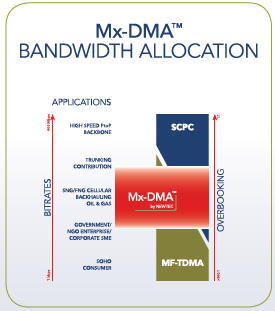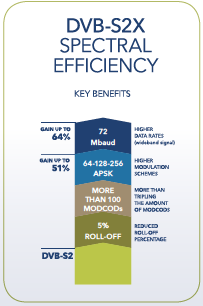Serge Van Herck, the CEO of Newtec, talked to SatMagazine about his vision, what potential dangers lay ahead and how Newtec is keeping their competitive edge to meet the growing demands of their customers.

SatMagazine
Serge, what pressures do you currently see in the marketplace and how is Newtec providing solutions for them?
Serge Van Herck
Our customers are always seeking new innovations in the market to improve the quality of their services and the efficiency of their networks. As a technology provider, the pressure is on Newtec to continuously provide reliable and highly efficient solutions to meet our customers’ needs.
Take the satellite broadcast industry, as an example. At Newtec, we have acknowledged these pressures and knew, for example, that as the industry moves from Standard Definition (SD) to High Definition (HD) to Ultra HD (UHD) television, and the demand for more bandwidth technology increases, we had to develop new technologies to bring more bits per hertz into play.
Our answer, in this case, was to team up with DVB to help create a new satellite transmission standard, DVB-S2X, to ensure that our industry can successfully move forward by employing reduced costs and increased speeds for clients. This new standard enables new services and higher transmission efficiency for the broadcast industry as well as for the VSAT industry.
With a strong demand for new satellite services such as Direct-To-Home (DTH) UHD4K broadcasting, the new DVB-S2X standard will prove an instrumental enabler. We have demonstrated transmissions to DTH terminals with the transmission scheme revealing as much as a 20 percent throughput gain, using an unaltered, regular, geostationary satellite transponder.
We have also recently delivered another new, return transmission technology to the market, which eliminates the headache for our customers of having to decide between SCPC and MF-TDMA return technologies. Our solution, Mx-DMA™ (or Cross-Dimensional Multiple Access), combines the best qualities of both technologies.
For fixed capacity services, Mx-DMA can bring more than a 35 percent bandwidth saving. This is the equivalent of putting 54 percent more customers into the same bandwidth when compared to SCPC.
For shared and overbooked services, the bandwidth saving of Mx-DMA is more than 50 percent, equivalent to bringing more than double the number of customers in the same bandwidth. In addition to the efficiency increase, Mx-DMA further improves signal availability, which helps our customers to further improve their quality of service.

Mx-DMA combines the best qualities of SCPC and MF-TDMA return technologies.
SatMagazine
Does the rise of High-Throughput Satellites (HTS) limit or increase available business opportunities for you in the market?
Serge Van Herck
The introduction of HTS, whether in Ka-, Ku- or C-band, is undoubtedly a blessing for our industry. HTS creates a new momentum that enables our data customers to offer telecommunication services which, in most cases, can be provided at a much lower cost than previously thought possible. This is key in order to stay competitive with alternative, terrestrial solutions.
The introduction of HTS has also had a major impact on the industry’s business model and value chain. The first US HTS were launched by technology companies that, over time, became fully vertically integrated; they operate their own telecom services on their own satellites. This has had a profound effect on the profitability and viability of other service providers and satellite operators who used to be their customers and suppliers in the past.
In the meantime, we have started to witness a new trend wherein the “traditional” satellite operators launch their own HTS on which they sell “MHz capacity” to their customers. I’m convinced that this trend is going to expand further to generate strong business opportunities for technology companies such as Newtec, who’s mission is to help their customers achieve their business objectives. However, let me be absolutely clear—Newtec has no ambition, whatsoever, to launch its own telecom service or HTS.
We have demonstrated with several customers that HTS works well with an open system architecture. We encourage VSAT operators and service providers to adapt to this approach. They will then have the flexibility to select the best equipment and modems for themselves, and can take full control of managing their system.

DVB-S2X, a new satellite transmission standard, reveals important throughput gain.
SatMagazine
You recently launched a new multi-service platform, Newtec Dialog®. In a multi-platform era, what does this mean for your customers?
Serge Van Herck
There is a constant shift in the satellite industry—some applications are being used more and other applications are being used less. Broadcasting services will always remain key to the industry. However, we have noticed that trunking applications over satellite have decreased due to more fiber being rolled out all over the world. Fortunately, we see that consumer broadband, mobile backhauling, Oil & Gas and mobility applications on land, sea and air really represent a major growth opportunity for many service providers.
Our new scalable multi-service platform, Newtec Dialog®, allows service providers to build and adapt their infrastructure easily as their business and the satellite market grows and changes. The platform gives our customers the flexibility to support any type of application, ranging from consumer and enterprise VSAT, to broadcast, to mobile backhauling, all from a single platform and with the knowledge that they are using the most efficient modulation and bandwidth allocation.
Newtec Dialog supports several return channel technologies, including our new Mx-DMA previously mentioned.
We take great pride in being able to develop these new innovative solutions for our customers and have been doing so for nearly three decades now. We share the same vision of watching our satellite industry develop and grow.
The feedback we receive from our customers and partners is always highly encouraging and this provides our engineers with the energy to continue pushing the technology boundaries forward to set new standards.
For additional information, please visit the Newtec infosite at http://www.newtec.eu/



